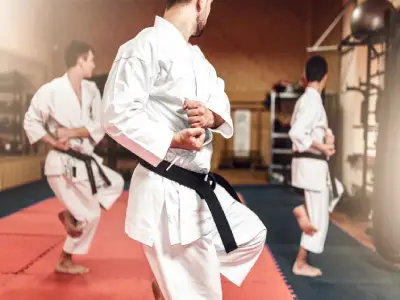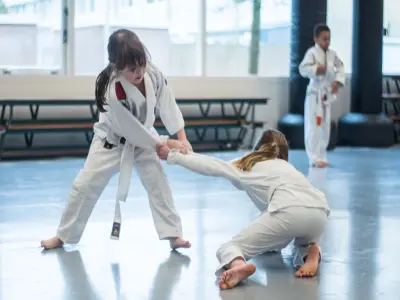Essential strength and conditioning exercises for martial arts are exceptional for your overall health and also help you in your martial arts practice. You may pick weighted exercises to increase your power, strength, and endurance. Focusing on a dependable martial art practice provides numerous benefits. The first thing that comes to mind is studying self-defense. Along with learning self-defense techniques, you will also get a lot of exercises.
Most people perceive martial arts as a less conventional exercise, especially when compared to treadmill jogging or weight lifting. However, it is a practical means of improving your well-being and health. The best advantage of martial arts is that you can start at any age, whether as children or as adults. There is no need for prior experience or a certain fitness level to begin practicing martial arts.
Are you contemplating taking martial arts lessons to improve your physical condition? Whether you want to study martial arts to get in shape, lose weight, defend yourself, learn how to fight, or participate in competitions, Pinnacle Martial Arts Academy keeps your best interests in mind. Our Monroe martial arts academy offers a well-organized program, a hygienic training facility, and an atmosphere that will undoubtedly boost your confidence and self-awareness. Members get limitless training with no contract, or you can sign up for a month-to-month payment option.
Let us guide you in your martial arts journey. Contact us right away to arrange a visit to our school immediately!
10 Essential Strength and Conditioning Exercises for Martial Arts
 Here are essential strength and conditioning exercises for martial arts that any martial artist should start doing now to improve their skills.
Here are essential strength and conditioning exercises for martial arts that any martial artist should start doing now to improve their skills.
Pull-ups
Pull-ups strengthen your upper-back muscles, which helps to increase upper body strength. These are necessary for controlling your opponent in Brazilian jiu-jitsu (BJJ), the Muay Thai clinch, and mixed martial arts.
If you can’t complete a good pull-up, start with easier workouts like negative pull-ups or jump pulls, which require standing on a platform. Jump or step on a platform to put your chin over the bar, then gently lower yourself.
These two progressions emphasize the downward controlled movement of the pull-up that will help develop the strength you need to perform a good pull-up successfully.
Whether you’re performing simple progressions or the proper pull-ups, squeeze your shoulder blades together so that your back muscles, instead of your biceps, are activated.
Push-ups
You can’t talk about martial arts strength and conditioning without the mention of the basic push-up. The push-up is beneficial for striking arts since the pushing movements help develop strength, allowing you to put more force in your punches.
Keep your arms tucked in and your hands under your shoulders for a good push-up. As you perform the motion, your elbows must slide along your rib cage.
Thrusters
Thrusters aid in the development of explosiveness as well as cardiovascular fitness. You start by standing with your two feet shoulder-width apart and holding the barbell in front of your shoulders. Position your wrists under the barbell. Perform a full squat and, as you rapidly extend your hips and legs, utilize the momentum of the upward motion to bring the bar over your head.
Overhead Presses
Overhead presses, which involve lifting dumbbells or kettlebells above your head from your shoulders, will help to strengthen your deltoids. Strong shoulders are essential for maintaining your guard, particularly when tired.
Strive for 8 to 12 reps. The weight must be heavy enough that the remaining three repetitions are difficult to complete. Keep your forearms parallel and your biceps in the top position, close to your ears.
Deadlifts
Deadlifts work your hamstrings, glutes, lower back muscles, and core while also strengthening your grip, making them ideal for BJJ.
When it comes to deadlifts, the emphasis must always be on good form, so don’t go too heavy initially.
As you look straight ahead, your toes should be pointed forward, and you shouldn’t round your back. Stick your buttocks back, and your knees should be slightly bent as you lower the bar in a vertical and straight motion. If your form is correct, you should feel the stretch in your hamstrings instead of your quads.
Barbell Squats
Squats with a barbell are another essential leg day exercise that targets your core, glutes, hamstrings, and quads. The focus must always be on form.
Front squats (in which the barbell rests on your shoulders beneath your chin) and back squats (in which the barbell rests on your shoulders at the back of your neck and trapezius muscles) are beneficial. Back squats, on the other hand, generally allow you to use heavier weights.
Anyone with lower back problems should avoid the back squat. To avoid additional pressure on your joints, steadily lower yourself using a three-second count, making sure your knees do not fold inwards and go farther than your toes. After reaching a complete squat, explode upwards before immediately lowering yourself.
Burpees
Burpees are not something that many people enjoy practicing, yet they are among the best bodyweight exercises for martial arts. The motion of sprawling and jumping back to your feet simulates many of the level changes required for grappling.
Burpees are also efficient in building endurance and cardiovascular fitness since they quickly increase your heart rate.
Resistance Bands
Resistance bands are a great training tool but must be used in moderation. Using bands too often can cause problems, but using them for conditioning exercises followed by technical practice can protect your form from deteriorating. Most people swear by its usefulness in training quick, snappy punching and kicks. Some disagree, claiming that it may reduce your technical abilities.
Depending on your exercise style and goals, you may encounter several problems when using resistance bands. For instance, going lazy on pulling your punch back — your extended fist will be stressed with the bands, and your return may become sloppy and lose speed. This may be remedied by slowing down your movement, improving form, and gradually extending and retracting your arm under resistance to work in both directions.
Another issue that some traditional martial artists may have is being overly tense while throwing a punch with the bands, which may not be as whip-like as you want. To avoid deterioration of your whip-like practice, practice without the resistance bands afterward to ensure you’re not degrading your form.
Weight Lifting
If resistance bands are not your thing, or you’re looking for a little more oomph, then gym and weight lifting come into play. By strategically using angles, you’ll do much better lying on your back, adding a barbell or dumbbell, and creating strength in a pushing-out movement from the chest. For increased strength hitting upwards, the incline bench press is preferable. If you are shorter than most people, you should consider this.
You could also help your downward strikes with a decline bench pressing motion. With this strategy, you compel your body to create the muscle change in a controlled and precise way, perhaps allowing you to apply greater force later.
Before diving in and researching all that you can concerning weight lifting to include it in your martial arts training, consider the following types of weight training. Strength is essential in martial arts, particularly as you advance through the ranks.
Be attentive and accountable for your tendency to depend on physical power rather than concentrating on technique.
- Weightlifting is concerned with developing your ability to generate a large amount of force rapidly. Weightlifting exercises include cleans, jerks, and snatches. These motions can considerably boost your strength, but they are technical moves to master and will need considerable practice at a lesser weight before you begin pushing yourself.
- Powerlifting is all about increasing raw strength. This typically comprises extensive compound exercises such as deadlifts, squats, bench presses, and others. Powerlifting may be a great way to boost your training.
- Bodybuilding is concerned with vanity gains, such as increasing size and look. Isolation motions and machines are often utilized approaches. However, they are ineffective for a martial artist who must employ functional strength from the whole body.
Jump Rope
Many people are afraid of jumping rope or have never learned how. It could be one of the most versatile, inexpensive, and efficient tools you could utilize. You can work on jogging, high jump (double under), lunges, changing direction, sprinting, and squats. You can even simulate a variety of exercises while jumping between to keep things fresh. This will loosen you up, allowing you to be lighter on your toes, improve your footwork, and increase your mobility and stamina for rapid tiny moves around the ring.
Jumping rope is effective because it challenges you to execute numerous repeating motions while acquiring good rhythm and coordination. Doing a hundred leaps in a minute will teach you to do that hop as efficiently as you can. Even 10 minutes of jump rope daily will enable you to outmove somebody who solely weight lifts every time. You will be much tougher to catch and tire with improved bounce and agility.
Join a World-Renowned Monroe Martial Arts Academy Now!
The Pinnacle Martial Arts Academy is a competitive training facility in Monroe, Louisiana. Our training facility provides martial arts classes for people of all ages, including Brazilian Jiu-Jitsu, Judo, kickboxing, wrestling, and even private one-on-one sessions!
Enroll with us now to get essential strength and conditioning exercises for martial arts!

